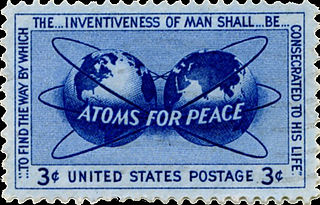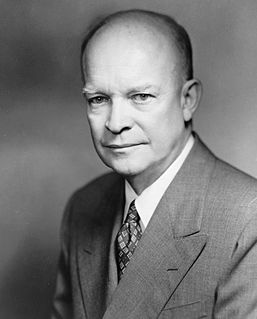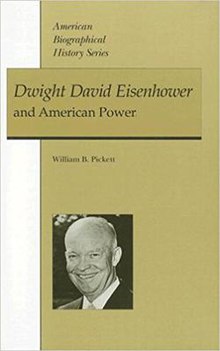
Dwight David "Ike" Eisenhower, GCB, OM was an American army general who served as the 34th president of the United States from 1953 to 1961. During World War II, he became a five-star general in the Army and served as Supreme Commander of the Allied Expeditionary Force in Europe. He was responsible for planning and supervising the invasion of North Africa in Operation Torch in 1942–43 and the successful invasion of Normandy in 1944–45 from the Western Front.

The 1952 United States presidential election was the 42nd quadrennial presidential election. It was held on Tuesday, November 4, 1952. Republican Dwight D. Eisenhower won a landslide victory over Democrat Adlai Stevenson, ending a string of Democratic Party wins that stretched back to 1932.

The military–industrial complex (MIC) is an informal alliance between a nation's military and the defense industry that supplies it, seen together as a vested interest which influences public policy. A driving factor behind this relationship between the government and defense-minded corporations is that both sides benefit—one side from obtaining war weapons, and the other from being paid to supply them. The term is most often used in reference to the system behind the military of the United States, where it is most prevalent due to close links between defense contractors, the Pentagon and politicians and gained popularity after a warning on its detrimental effects in the farewell address of President Dwight D. Eisenhower on January 17, 1961.

John Sheldon Doud Eisenhower was a United States Army officer, diplomat, and military historian. The son of President Dwight D. Eisenhower, his decorated military career spanned from before, during, and after his father's presidency, and he retired from active duty in 1963 and then altogether in 1974. From 1969 to 1971, he served as United States Ambassador to Belgium during the administration of President Richard Nixon, who was previously his father's vice president.

The 1952 Republican National Convention was held at the International Amphitheatre in Chicago, Illinois from July 7 to 11, 1952, and nominated the popular general and war hero Dwight D. Eisenhower of New York, nicknamed "Ike," for president and the anti-communist crusading Senator from California, Richard M. Nixon, for vice president.

"Atoms for Peace" was the title of a speech delivered by U.S. President Dwight D. Eisenhower to the UN General Assembly in New York City on December 8, 1953.
I feel impelled to speak today in a language that in a sense is new – one which I, who have spent so much of my life in the military profession, would have preferred never to use. That new language is the language of atomic warfare.

In political studies, surveys have been conducted in order to construct historical rankings of the success of individuals who have served as the president of the United States. Ranking systems are usually based on surveys of academic historians and political scientists or popular opinion. The rankings focus on presidential achievements, leadership qualities, failures, and faults.

The New Look was the name given to the national security policy of the United States during the administration of President Dwight D. Eisenhower. It reflected Eisenhower's concern for balancing the Cold War military commitments of the United States with the nation's financial resources. The policy emphasised reliance on strategic nuclear weapons as well as a reorganisation of conventional forces in an effort to deter potential threats, both conventional and nuclear, from the Eastern Bloc of nations headed by the Soviet Union.
The Draft Eisenhower movement was the only successful political draft of the 20th century to take a private citizen to the Oval Office. It was a widespread American grassroots political movement that eventually persuaded Dwight D. Eisenhower to run for President. The movement culminated in the 1952 presidential election in which Eisenhower won the Republican nomination and defeated Democrat Adlai Stevenson to become the 34th President of the United States.
These are the references for further information regarding the history of the Republican Party in the U.S. since 1854.

The presidency of Dwight D. Eisenhower began at noon EST on January 20, 1953, with his inauguration as the 34th President of the United States, and ended on January 20, 1961. Eisenhower, a Republican, took office as president following his victory over Democrat Adlai Stevenson in the 1952 presidential election. John F. Kennedy succeeded him after winning the 1960 presidential election.
Robert Hugh Ferrell was an American historian and a prolific author or editor of more than 60 books on a wide range of topics, including the U.S. presidency, World War I, and U.S. foreign policy and diplomacy. One of the country's leading historians, Ferrell was widely considered the preeminent authority on the administration of Harry S. Truman, and also wrote books about half a dozen other 20th-century presidents. He was thought by many in the field to be the "dean of American diplomatic historians," a title he disavowed.

The 1952 Republican presidential primaries were the selection process by which voters of the Republican Party chose its nominee for President of the United States in the 1952 U.S. presidential election. Former U.S. Army General Dwight D. Eisenhower was selected as the nominee through a series of primary elections and caucuses culminating in the 1952 Republican National Convention held from July 7 to July 11, 1952, in Chicago, Illinois.
The Chance for Peace speech, also known as the Cross of Iron speech, was an address given by U.S. President Dwight D. Eisenhower on April 16, 1953, shortly after the death of Soviet dictator Joseph Stalin. Speaking only three months into his presidency, Eisenhower likened arms spending to stealing from the people, and evoked William Jennings Bryan in describing "humanity hanging from a cross of iron." Although Eisenhower, a former military man, spoke against increased military spending, the Cold War deepened during his administration and political pressures for increased military spending mounted. By the time he left office in 1961, he felt it necessary to warn of the military-industrial complex in his final address.

The 1956 United States presidential election in New York took place on November 6, 1956. All contemporary 48 states were part of the 1956 United States presidential election. New York voters chose 45 electors to the Electoral College, which selected the president and vice president.
This bibliography of John F. Kennedy is a list of published works about John F. Kennedy, 35th President of the United States.
This bibliography of Dwight D. Eisenhower is a list of published works about Dwight D. Eisenhower, 34th President of the United States.
William Beatty Pickett is an American historian and professor emeritus at Rose-Hulman Institute of Technology in Terre Haute, Indiana. He is known as an authority on President Dwight D. Eisenhower and Indiana Sen. Homer E. Capehart, and is the author of several well-regarded books on U.S. history including Dwight David Eisenhower and American Power and Eisenhower Decides To Run: Presidential Politics and Cold War Strategy.

Eisenhower Decides to Run: Presidential Politics and Cold War Strategy is a 2000 book by historian William B. Pickett, a professor at Rose-Hulman Institute of Technology in Terre Haute, Indiana. It follows his 1995 Eisenhower biography Dwight David Eisenhower and American Power, and looks specifically at the reasons behind the five-star general's fateful choice to enter politics and become a candidate for the Republican nomination during the 1952 presidential campaign.
The foreign policy of Dwight D. Eisenhower administration was the foreign policy of the United States from 1953 to 1961, when Dwight D. Eisenhower served as the President of the United States. Eisenhower held office during the Cold War, a period of sustained geopolitical tension between the United States and the Soviet Union.











